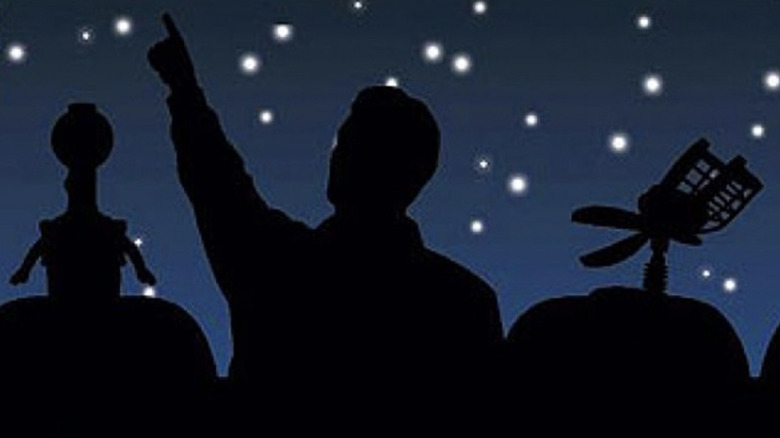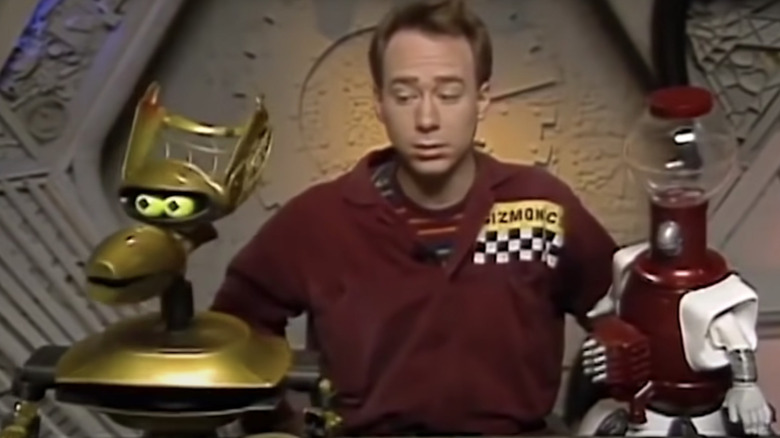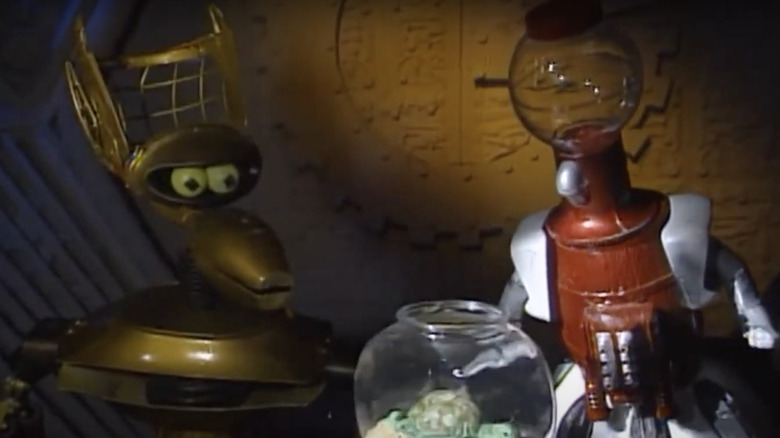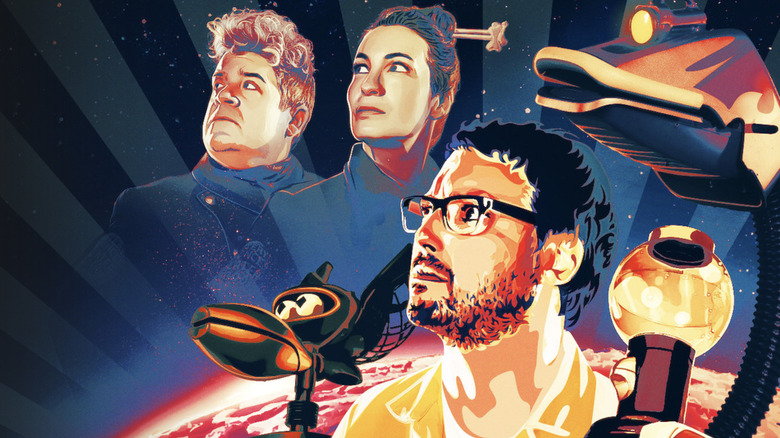Why Mystery Science Theater 3000's Founding Duo Eventually Split
In the '60s, before cable, streaming services, and The World Wide Web, there were three channels on television. But, even with its limited options, TV still captured the attention of kids at the time, and one of those kids was Joel Hodgson.
Unlike today, Hodgson couldn't fire up Netflix and pick the films he wanted to see. He watched whatever those three channels had to offer, which might sound like some form of bizarre torture to modern audiences, but the lack of options didn't stop the young guy from loving television. A self-described "TV junkie," Hodgson would watch everything from polka shows to farm reports, rejoicing when he came across a monster movie.
He would explore magic, ventriloquism, and stand-up comedy throughout his early to mid-20s. While he had some success in stand-up in the '80s, his early exposure to B-movies would lead to his greatest creation, "Mystery Science Theater 3000," or "MST3K," as fans call it.
The original series consisted of a guy (Hodgson) living on an earth-orbiting spaceship called "The Satellite of Love." He is studied by mad scientists as he's forced to watch horribly bad B-movies. To make watching these films more bearable, Joel makes fun of them with a couple of robot friends he created to keep him company.
"MST3K" puts us all back into a world where your only viewing option is a dumpster fire of a movie, except we have Joel and his robots to help us laugh through it. But, in 2014, Wired interviewed the show's creators, who revealed that behind the scenes of wit, sarcasm, and robots, things didn't stay so lighthearted.
'My opinion means nothing in Hollywood'
According to Wired, in 1982, Hodgson left Minneapolis to pursue stand-up comedy in LA. Throughout his time there, he appeared on "Letterman" and "Saturday Night Live," and received an offer for a Michael J. Fox show, "High School U.S.A." He turned it down, explaining to Wired:
"I didn't think it was funny and said no. They doubled the money, and that kind of offended me. I realized, oh, that's right, my opinion means nothing in Hollywood. I'd seen other people compromise, and I felt that once you gave up on what you wanted to do, you couldn't go back. It was selling out."
Hodgson, in an attempt to keep his artistic integrity, left Hollywood and went back to Minneapolis. Say what you want about the man, but few people believe so strongly in their principles that they'd turn down screentime with Michael J. Fox to work in a t-shirt factory, but that's exactly what he did.
His modest success as a comedian in Hollywood caused a bit of a buzz around him back in Minneapolis, which would make networking with producers and other comedians easier. This popularity would draw production manager, Jim Mallon, to offer Hogdson a TV spot on his network, KTMA.
Let's riff on this
KTMA was a small, Minneapolis TV station that owned a film library full of movies nobody wanted to watch, but that was exactly what Hodgson needed to pull off his idea. In that same Wired article, he explained that "MST3K" was:
"... an idea I'd had tucked away in the back of my mind since high school: On Elton John's "Goodbye Yellow Brick Road" album, there are illustrations in the liner notes. And for the song "I've Seen That Movie Too," it's got little silhouettes watching a movie. I remember [thinking that] someone should do a show like that. Run a movie and have these people in silhouettes say stuff."
His idea of riffing on movies paired perfectly with KTMA's library full of celluloid nightmares, and "MST3K" was born.
Hodgson and Mallon agreed to be partners, which meant they each owned 50% of the show. Hodgson would be the creative lead, while Mallon was in charge of the technical and business sides of things. This partnership seemed to work fine at the beginning of the show, but that changed pretty quickly after the series was picked up by The Comedy Channel (now Comedy Central).
Art Bell, a Comedy Central executive at the time, told Wired that:
" ... "Mystery Science Theater 3000" really got noticed. It became a cult hit, which was good enough for us in the first six months. It was the Comedy Channel's first attention-getting show, in a big way."
The surge in viewers, and how to take advantage of it, would lead to creative differences between Hodgson and Mallon. They both agreed to capitalize on the attention and success by attempting to make an "MST3K" movie, but they didn't agree on much of anything else. In fact, when they both spoke to Wired, each had very different memories of what exactly went down between the two of them.
Mallon insists that Hodgson was power-tripping and acted as if everyone worked for him, which caused tension among the crew:
"I think Joel operated under the idea that this was his show, and everyone was working for him. And everyone else was into this sort of cooperative mode—that it's all of us working together. So it would be somewhat analogous to John Cleese saying, 'Oh, by the way, this is my show, and you guys work for me.' The rest of the Pythons would have probably taken exception with that."
Hodgson claims that Mallon wanted to produce and direct the movie, which left him feeling powerless and wondering what his contribution would be. We'll never know which story is truthful, but we know that the partnership ended when Hodgson decided to leave the series in 1993:
"I was fighting with Jim Mallon. We had decided, oh, let's be like Star Trek: The Next Generation and do a movie. Instead of 22 movies a year, we'll do one really good one and be rich and famous. And that's when Jim said, 'OK, well, I'm the producer and I'm the director.' And I just felt like that didn't acknowledge my position. I'm like, I created this. Where's my acknowledgment? I felt that was kind of a power grab on his part. We were an ensemble. We did everything as a group. So that's when I kind of said, 'If you direct this, I'm leaving.' And it just all fell apart after that."
The show goes on
The show's head writer, Mike Nelson, replaced Hodgson on-screen after his departure, and, although there would be cast changes throughout the years, "MST3K" remained on Comedy Central until the mid-90s. After that, the series had a brief stint on The Sci-Fi Channel, but the show's humor didn't land with the network's executives. Mallon continued to produce the series until its cancelation in 1999.
But, that wasn't the permanent end of "The Satellite of Love."
In 2015, the entertainment company Shout! Factory acquired the rights to "MST3K" from Mallon's company Best Brains, Inc., which put Hodgson back in creative control of the show. The original creator teamed up with Netflix and revived the series in 2017. It lasted two seasons before, again, being canceled, but fans weren't done with it.
Thanks to a successful Kickstarter campaign by the series creator, "MST3K" now has its very own streaming platform, "The Gizmoplex," which has 13 seasons of hand-picked, deliciously awful B-movies waiting for you. Oh yeah, and some wisecracking robots.



